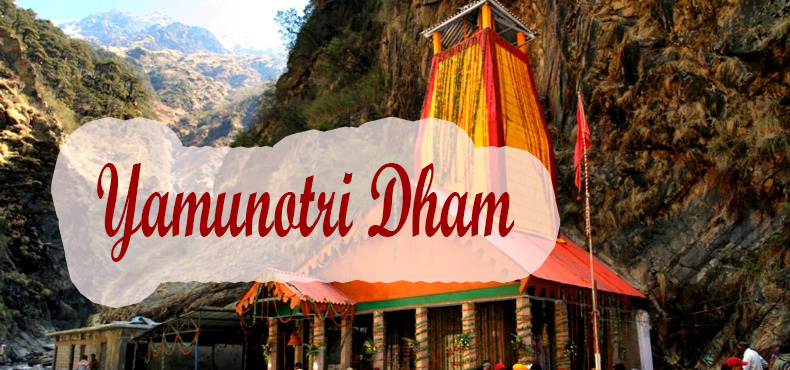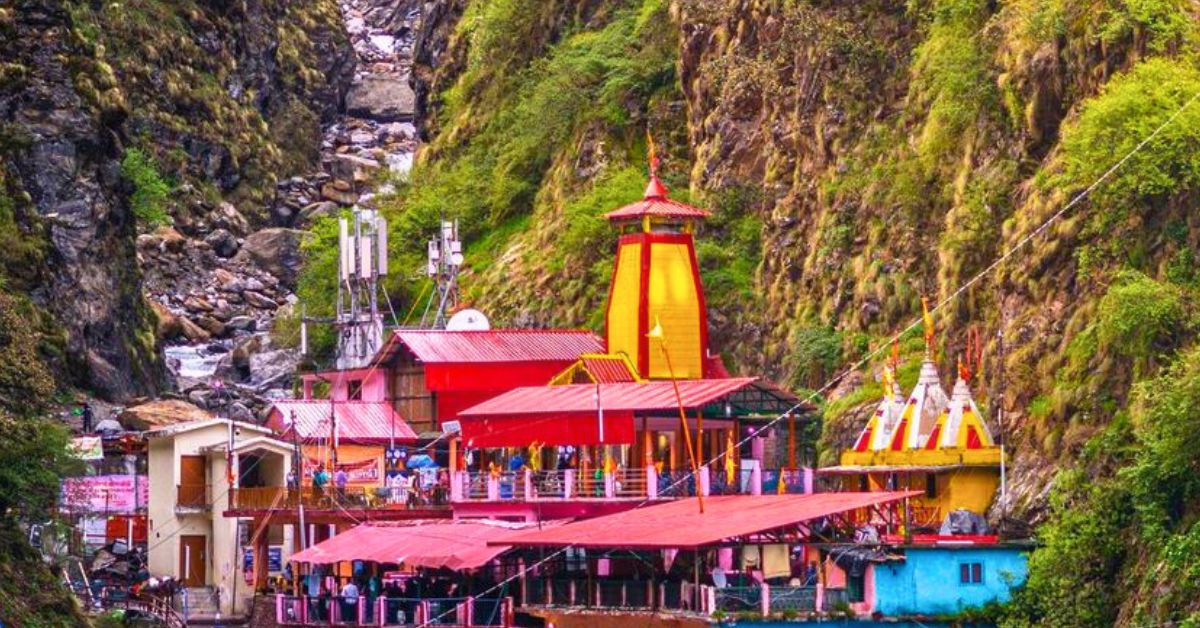 Yamunotri
Yamunotri
 History
History

30 Apr 2025 to 23 Oct 2025 (tentative)

There are many stories and tales concerning Yamunotri's past in Hinduism. People say that the river goddess, who is also the daughter of Surya, the Sun God, lives here. People believe that Yamunotri is not just her spiritual home but also where the holy Yamuna River starts. This river is thought by many to be one of the holiest in India. They think that swimming in its waters washes away all sins and keeps people from dying too soon.
Hindus believe that Sage Asit Muni, a learned man, lived and thought in Yamunotri. They knew he swam in the Ganges and Yamuna rivers every day. As he got older and couldn't go to Gangotri any longer, a mystical stream of the Ganges appeared next to the Yamuna to help him keep up his spiritual practice. Yamunotri became even more holy after a significant event occurred. Maharani Guleria of Jaipur established the current Yamunotri temple in the 1800s. Floods and landslides have repeatedly destroyed the ancient temple. Even though it's hard to get there and the ground is harsh, Yamunotri has been a favorite destination for a long time. They risked their lives by climbing in harsh weather on tough slopes to get God's blessing.
The Puranas and the Skanda Purana are two old books that also mention Yamunotri. The Yamuna River and the area around it are incredibly important and holy to people. People think that the Yamuna is nicer and calmer than the Ganga since she is Yama's sister, the god of death. Some people assume that if they pray to Yamuna, Yama will have pity on them.
The temple doesn't look like much, yet it has a lot of spiritual energy. The building sits on the left side of the Yamuna River and is composed of black marble and wood. A black stone statue of Goddess Yamuna and a white marble statue of Goddess Ganga are next to each other in the sanctum. The first thing people do is pray at the Divya Shila, which is a granite pillar beside the temple. They then go inside to pray.
Surya Kund, a hot water spring near the temple, is another important part of the site's history and culture. Pilgrims cook rice and potatoes that are wrapped in linen in the hot waters of the kund. Then they give these to the god as prasad. Some people believe that the hot springs may heal and purify the spirit.
It used to be harder to get to Yamunotri. It took a long time to trek through thick woods and across high cliffs. The travel to Janki Chatti is easier now that there are roads, but the spiritual meaning of the pilgrimage hasn't altered. During the six-month pilgrimage season, the road is filled with chanting, bells, and the colorful culture of the Garhwal region.
The Yamunotri temple is closed in the winter because it gets a lot of snow. People come to Kharsali village in large numbers to pray to the goddess Yamuna. The ceremonial moving of the idol is a significant event that signifies the enduring nature of faith, even during difficult times.
Yamunotri is still a key part of the Char Dham Yatra. It stands for purity, power, and determination. Yamunotri is a destination where pilgrims can see a rare combination of legendary history, beautiful scenery, and deep peace that has inspired people for hundreds of years.
Himalayan Sanctity and Pre-Vedic Importance:
Before the organisation of Hinduism, people believed the Himalayas to be a sacred place where wise men contemplated and communicated with gods. Yamunotri was a naturally magical spot since it sat in the heart of these huge mountains. People think that the tribes who lived in the area before Vedic civilisation thought the Yamuna River was a god who gave them life and kept them safe. These early connections led Yamunotri to become a shakti sthala, or power point, where spiritual energy comes together. The site's energy attracted wandering yogis, seekers, and others who worship nature even before temples were built.
Connection to Sage Bharadwaj and Old Rituals:
There are further anecdotes about Sage Bharadwaj that mention Yamunotri, in addition to its well-known link to Asit Muni. People in ancient India thought Bharadwaj Rishi was a smart person and a good teacher. He told his followers to perform austerities near the source of the Yamuna River since it is pure and has a holy origin. The residents of this area honoured the Yamuna River and prayed to the elements—fire, water, air, and space—demonstrating their spiritual connection to nature. During the equinoxes and solstices, people would give the river seasonal fruits, Himalayan herbs, and sacred ash as part of their seasonal ritual.
Impact on Bhakti Movements in the Middle Ages:
During the Bhakti movement, which lasted from the 12th to the 16th centuries, Yamunotri also became a location to pray. Many poets and saints from North India wrote poems about Yamuna as a goddess, a mother, and a spiritual guide. During this time, people focused more on their personal lives, and the river was regarded as a symbol of grace and the release of emotions. Many Bhakti poets thought that the trek was a metaphor for the soul's journey towards pure truth. The spiritual story of Yamunotri grew to contain lyrical symbolism.
Changes in pilgrimage and things to note throughout the British era:
When the British were in charge of India, explorers and government officials understood how vital Yamunotri was for the environment and for people. British surveyors wrote notes about the temple, the hiking trails, and the hot springs as part of their mapping missions in the Himalayas. While there were some foreign influences on the trip to Yamunotri, the experience remained predominantly native. Pahadi villages preserved their oral histories, seasonal festivals, and ecological rites. Some British-era documents say that individuals would carry water from the Ganga and Yamuna rivers in copper pots all the way to the plains. This evidence shows how powerful and devoted the pilgrims were before roads were built.
The Role of Women and Local Custodians:
It's also fascinating that women have played such a big role in Yamunotri's history. Feminine energy is a vital part of keeping the site secure. Maharani Guleria toiled to fix it in the 1800s, and local Garhwali women help and guide pilgrims today. Oral stories that have been passed down through the years generally characterise Goddess Yamuna as a forceful yet loving mother figure who helps both good and bad people. Kharsali and adjacent village women assist with daily rituals, maintain the temple's cleanliness, and tend to the sacred trees. Yamunotri's spiritual leadership is unique because it includes both men and women.
The awareness of environmental issues and the legacy of conservation are significant aspects of Yamunotri's cultural identity.
For a long time, Yamunotri has been a sign of care about the environment. People have always cared for the trees and riverbanks because they believed in the goddess of the river. Tradition has kept sacred groves near Yamunotri safe, where hunting and logging were not allowed. Long before ecotourism rules were formed, priests and locals worked hard to keep the hiking trails and streambeds clean every season. Yamunotri is a paradigm for eco-friendly religious tourism since it combines old and new techniques to conserve the environment.
Getting involved in modern spiritual tourism:
When India became free, spiritual tourism grew, and people from all over the world, not only India, began to visit Yamunotri. Tour companies and religious groups started to market Yamunotri as a place for yoga hikes, wellness retreats, and spiritual immersions. There was a lot of information online about how to arrange pilgrimages, temple hours, and itineraries from the government and sites like Sacred Yatra. Such information made it easier and safer to go to. Even if Yamunotri's rituals, traditions, and spiritual essence have changed throughout time, they are still very much alive. It is a place where history, devotion, and Himalayan mysticism all meet.
1. Mythological Significance: There is a lot of mythology in Yamunotri, and it has to do with the Sun God's daughter, Goddess Yamuna. People say that Sage Asit Muni was so religious that his faith brought Yamuna and Ganga together at this holy place.
2. Sage Asit Muni’s Penance: The Ganga appeared next to the Yamuna at Yamunotri as a sign of respect for Sage Asit Muni's daily baths in the Ganga and Yamuna. This allowed the sage to keep praying even though he was getting older and weaker.
3. Original Temple Structure: Maharaja Pratap Shah of Tehri Garhwal paid for the first Yamunotri temple, which shows that the royal family supported it. The weather wrecked it a few times, but it was fixed and stayed a place of prayer.
4. Renovation by Royalty: In the 1800s, Maharani Guleria of Jaipur paid to have the temple fixed. This kept the tradition alive and helped others in the future connect with the spiritual essence of Yamunotri.
5. Inclusion in Char Dham: It was easier to observe how important Yamunotri is after it became a Char Dham site. It became the first stop for millions of people going to the Himalayas since the roads got better and there was more information.
6. Ritual Continuity: Even though a lot of time has gone, important things like boiling rice in Surya Kund and praying at Divya Shila are still the same. This creates a strong spiritual connection between people of all ages.
7. Modern Spiritual Tourism: Individuals on spiritual journeys and those on pilgrimages visit Yamunotri. The temple's famous history and peaceful environment still draw people from all across India and the world, even though the infrastructure has gotten better.
| Yamunotri Opening Date of 2026 | Yamunotri Closing Date of 2026 |
|---|---|
| 30 Apr 2025 | 23 Oct 2025 (tentative) |
| Yamunotri Facts | |
|---|---|
| Area | 3 sq kms |
| Altitude | 3235 mts |
| District | Uttarkashi |
| State | Uttrakhand |
| Season | Apr - Oct |
| Famous for | Pilgrim, Trekking |
| Pincode | 249193 |
| STD Code | 01374 |
